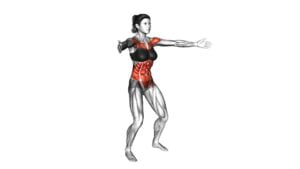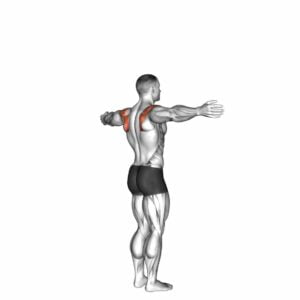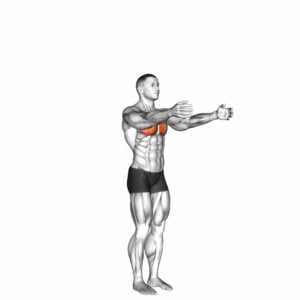Shoulder – Transverse Flexion – Video Exercise Guide & Tips

Are you looking to improve your shoulder strength and flexibility?
Watch This Exercise Video
In this video exercise guide, you'll learn all about shoulder transverse flexion and how it can benefit you.
By targeting specific muscles in your shoulders, this exercise can help enhance your overall upper body strength and stability.
You'll also discover proper form and technique, common mistakes to avoid, and modifications to suit your fitness level.
Get ready to incorporate shoulder transverse flexion into your workout routine for maximum results.
Key Takeaways
- Improved shoulder stability
- Enhanced shoulder mobility
- Better posture
- Prevention of neck and upper back pain
Benefits of Shoulder Transverse Flexion
You can maximize your shoulder strength and flexibility by incorporating shoulder transverse flexion exercises into your workout routine. Shoulder transverse flexion exercises involve moving your arm across your body in a horizontal motion, targeting the muscles in the front of your shoulder.
One of the key benefits of shoulder transverse flexion exercises is improved shoulder stability. The muscles involved in this movement, such as the anterior deltoid and pectoralis major, help stabilize the shoulder joint and prevent injuries during daily activities and sports.
Additionally, these exercises can enhance your overall shoulder mobility. By regularly performing shoulder transverse flexion exercises, you can increase the range of motion in your shoulder joint, allowing for better movement in activities such as reaching, lifting, and throwing.
Moreover, shoulder transverse flexion exercises can also contribute to better posture. The muscles targeted in these exercises play a crucial role in maintaining proper shoulder alignment, which in turn can help alleviate neck and upper back pain caused by poor posture.
Muscles Targeted in Shoulder Transverse Flexion
When performing shoulder transverse flexion exercises, the muscles targeted are those that assist in stabilizing the shoulder joint and promoting better mobility. These exercises primarily engage the deltoid muscle, specifically the anterior fibers. The deltoid is a large muscle that covers the shoulder joint and is responsible for various movements, including flexion, abduction, and rotation. By targeting the anterior fibers of the deltoid, shoulder transverse flexion exercises help to improve shoulder mobility and strengthen the muscles involved in this movement.
In addition to the deltoid, other muscles in the shoulder also play a role in shoulder transverse flexion. The rotator cuff muscles, which include the supraspinatus, infraspinatus, teres minor, and subscapularis, work together to stabilize the shoulder joint during movements. These muscles help to maintain proper alignment and prevent injuries during shoulder exercises.
Engaging the muscles targeted in shoulder transverse flexion exercises not only improves shoulder mobility but also enhances overall upper body strength and stability. It's important to perform these exercises with proper form and technique to ensure optimal muscle engagement and prevent any potential injuries. Incorporating shoulder transverse flexion exercises into your workout routine can help to improve your shoulder mobility and strengthen the muscles involved in this movement, contributing to better overall shoulder health.
Proper Form and Technique for Shoulder Transverse Flexion
To ensure proper form and technique for shoulder transverse flexion, there are a few common mistakes you should avoid.
First, be mindful not to use excessive momentum or swinging motions, as this can compromise the effectiveness of the exercise and increase the risk of injury.
Additionally, maintain a controlled and steady movement throughout the exercise, focusing on engaging the targeted muscles for optimal results.
Common Mistakes to Avoid
Avoid the common mistakes that can hinder your progress and effectiveness in performing shoulder transverse flexion exercises. Proper form is crucial to ensure that you're targeting the right muscles and minimizing the risk of injury.
One common mistake is using excessive weight, which can compromise your form and lead to strain on the shoulders and neck. Another mistake is allowing the elbows to flare out instead of keeping them close to the body. This can shift the focus away from the shoulder muscles and onto the chest and triceps.
Additionally, avoid using momentum to swing the weights up, as this reduces the effectiveness of the exercise. Instead, focus on controlled and deliberate movements to fully engage the shoulder muscles.
Tips for Better Execution
Maintain proper form and technique for optimal results when performing shoulder transverse flexion exercises. To improve flexibility and avoid injuries, it's crucial to execute the exercise correctly.
Start by standing tall with your feet shoulder-width apart and your core engaged. Hold a dumbbell or resistance band with both hands, palms facing inward.
Begin the movement by raising your arms out to the sides, keeping them straight and parallel to the floor. Slowly bring your arms forward, crossing them in front of your body until they're in line with your shoulders. Avoid hunching your shoulders or leaning forward during the exercise.
Control the movement and focus on engaging your shoulder muscles throughout. Remember to breathe properly and maintain a smooth and controlled motion.
Common Mistakes to Avoid in Shoulder Transverse Flexion
Make sure you maintain proper form to prevent common mistakes in shoulder transverse flexion. This exercise is crucial for strengthening the muscles in your shoulders and improving your overall upper body strength. However, if not performed correctly, it can lead to injuries and ineffective results. To avoid these common mistakes and get the most out of your shoulder transverse flexion, here are some tips for better execution.
One common mistake is using excessive weight. It's important to start with a lighter weight and gradually increase it as your strength improves. Using too much weight can compromise your form and put unnecessary strain on your shoulders.
Another mistake to avoid is swinging your arms. This can take away the focus from the targeted muscles and increase the risk of injury. Make sure to keep your movements controlled and avoid any swinging or jerking motions.
Additionally, improper positioning of your body can affect the effectiveness of the exercise. Keep your spine straight, engage your core, and maintain a slight bend in your knees. This will help stabilize your body and ensure that the movement is isolated to your shoulders.
Lastly, rushing through the exercise is a common mistake. Take your time and perform each repetition with proper form and control. This will maximize the benefits and reduce the risk of injury.
Modifications and Progressions for Shoulder Transverse Flexion
To further enhance your shoulder transverse flexion exercise, consider implementing modifications and progressions that will challenge your muscles and promote continued growth and strength.
Modifications allow you to adjust the exercise to suit your individual needs, while progressions help you advance to more difficult variations as you become stronger and more proficient.
One modification you can try is using a lighter resistance band or weight to decrease the intensity of the exercise. This can be helpful if you're just starting out or if you have any shoulder limitations. Additionally, you can modify the range of motion by performing the exercise with a smaller movement, focusing on maintaining proper form and control.
To progress the shoulder transverse flexion exercise, you can increase the resistance band or weight to provide a greater challenge to your muscles. This will help to build strength and improve your overall performance. Another progression is to perform the exercise on an unstable surface, such as a Bosu ball or balance board. This will engage your core muscles and improve your stability and balance.
Remember to always listen to your body and progress at a pace that's comfortable for you. Consult with a qualified fitness professional if you have any concerns or questions about modifications and progressions for shoulder transverse flexion.
Tips for Incorporating Shoulder Transverse Flexion Into Your Workout Routine
To seamlessly incorporate shoulder transverse flexion into your workout routine, begin by gradually increasing the resistance and challenging your muscles with each repetition. This will help to strengthen and tone the muscles of your shoulder joint, enhancing your overall upper body strength and stability. When incorporating resistance into your shoulder transverse flexion exercises, you can use dumbbells, resistance bands, or even a cable machine. Start with a weight or resistance level that allows you to perform 8-12 repetitions with proper form and control. As you become more comfortable and stronger, gradually increase the weight or resistance to continue challenging your muscles.
For beginners, it's important to start with variations that are suitable for your current fitness level. One variation is the standing band shoulder transverse flexion. Begin by standing with your feet shoulder-width apart and holding a resistance band with both hands. Start with your arms extended straight in front of you, parallel to the floor. Slowly pull the band outward, away from your body, while maintaining a slight bend in your elbows. Return to the starting position with control and repeat for the desired number of repetitions.
Incorporating shoulder transverse flexion into your workout routine can be beneficial for improving shoulder strength, stability, and overall upper body function. By gradually increasing the resistance and incorporating variations suitable for beginners, you can effectively challenge your muscles and progress towards your fitness goals.
Frequently Asked Questions
Can Shoulder Transverse Flexion Help Improve Shoulder Stability?
Shoulder transverse flexion can indeed help improve shoulder stability. By engaging the muscles responsible for stabilizing the shoulder joint, such as the rotator cuff and deltoids, this exercise promotes a strong and stable shoulder girdle.
Performing shoulder transverse flexion with proper form is crucial to maximize its benefits. Ensure your elbow is at a 90-degree angle, maintain control throughout the movement, and avoid any excessive swinging or jerking motions.
This exercise can be an effective addition to your shoulder stability training routine.
Is Shoulder Transverse Flexion Suitable for Individuals With Shoulder Injuries?
Shoulder transverse flexion is a commonly recommended exercise for shoulder rehabilitation. However, if you have a shoulder injury, it may not be suitable for you.
It's important to consult with a healthcare professional or a physiotherapist to determine the best course of action for your specific injury. They may recommend alternatives to shoulder transverse flexion that can help improve shoulder stability without aggravating your injury.
How Frequently Should Shoulder Transverse Flexion Exercises Be Performed?
Shoulder transverse flexion exercises should be performed with a frequency that allows for optimal muscle activation and recovery. The frequency can vary depending on individual factors such as fitness level and specific goals. However, it's generally recommended to perform these exercises 2-3 times per week.
Consistency is key in order to see the benefits of shoulder transverse flexion. These benefits include improved shoulder stability, increased range of motion, and enhanced overall upper body strength.
Can Shoulder Transverse Flexion Help Enhance Overall Upper Body Strength?
Shoulder transverse flexion, a beneficial exercise technique, can indeed enhance overall upper body strength. By engaging the muscles in your shoulder, chest, and upper back, this movement promotes muscle growth and improves stability in your upper body.
Regularly incorporating shoulder transverse flexion exercises into your workout routine can lead to increased strength and improved performance in activities that require upper body strength.
To ensure proper form and maximize the benefits, consult a fitness professional for guidance on shoulder transverse flexion techniques.
Are There Any Specific Warm-Up Exercises Recommended Before Performing Shoulder Transverse Flexion?
Before performing shoulder transverse flexion, it's important to incorporate specific warm-up exercises to prepare your muscles and joints for the movement. Recommended exercises for warming up the shoulder muscles include:
- Arm circles
- Shoulder rolls
- Shoulder stretches
These exercises help increase blood flow, improve flexibility, and reduce the risk of injury during the main exercise. Remember to start with lighter weights or resistance bands and gradually increase the intensity as you warm up.
Conclusion
Incorporating shoulder transverse flexion into your workout routine can bring numerous benefits. This exercise targets the muscles in your shoulders, helping to improve overall strength and stability. By following proper form and technique, you can maximize the effectiveness of this exercise and avoid common mistakes.
Additionally, modifications and progressions can be made to challenge yourself further. Add shoulder transverse flexion to your routine to enhance your upper body strength and overall fitness.

Author
Years ago, the spark of my life’s passion ignited in my mind the moment I stepped into the local gym for the first time. The inaugural bead of perspiration, the initial endeavor, the very first surge of endorphins, and a sense of pride that washed over me post-workout marked the beginning of my deep-seated interest in strength sports, fitness, and sports nutrition. This very curiosity blossomed rapidly into a profound fascination, propelling me to earn a Master’s degree in Physical Education from the Academy of Physical Education in Krakow, followed by a Sports Manager diploma from the Jagiellonian University. My journey of growth led me to gain more specialized qualifications, such as being a certified personal trainer with a focus on sports dietetics, a lifeguard, and an instructor for wellness and corrective gymnastics. Theoretical knowledge paired seamlessly with practical experience, reinforcing my belief that the transformation of individuals under my guidance was also a reflection of my personal growth. This belief holds true even today. Each day, I strive to push the boundaries and explore new realms. These realms gently elevate me to greater heights. The unique combination of passion for my field and the continuous quest for growth fuels my drive to break new ground.



